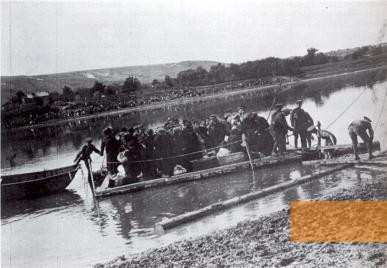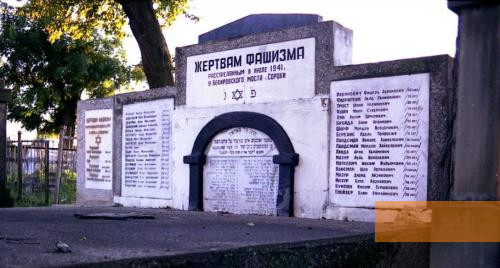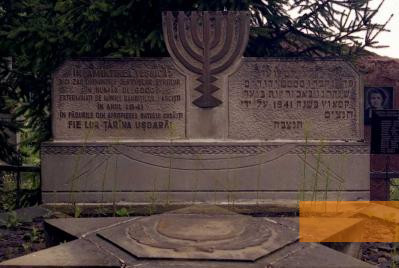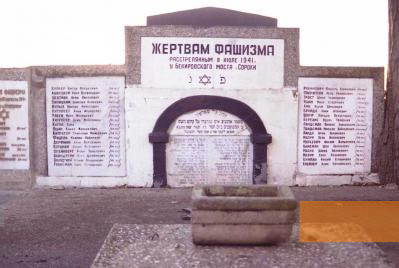Several monuments in the Moldovan small town of Soroca (Russian: Soroki) commemorate the town's Jews who were murdered by Romanian units in July 1941. The Romanian authorities later deported almost all of the Jewish residents of Soroca to Transnistria.
The Jewish community of Soroca (Russian: Soroki), today located in the north of the Republic of Moldova on the western bank of the river Dniester, is one of the oldest communities in the historical region of Bessarabia. Jews probably first settled here in the 16th century; Soroca consequently became a centre of Jewish life. In 1930, there were about 5,400 Jews living in Soroca, over a third of the total population. In 1940, the Soviet Union occupied Bessarabia – which had since 1918 been part of Romania – including Soroca. Following the joint invasion of the Soviet Union in June 1941, German and Romanian troops occupied the town in July. Immediately afterwards, Romanian constabulary murdered about 200 Jews.
When the German troops continued east, the town remained under Romanian occupation. At the end of July 1941, Romanian units began expelling Jews from the north of Bessarabia. They forcibly rounded up about 5,000 to 6,000 Jews and brought them across the river Dniester to Yampil in occupied Ukraine. The German occupying forces at first allowed the Jewish treks to pass. The hungry and terrified people wandered around Yampil searching for food. Town commander major Klemm eventually ordered the German troops to gather all of the Jews in a closed-off part of town and to expel them back to Soroca on the other side of the Dniester. Many elderly people and children died on the marches. Jews who refused to cross the river or who tried to return to Yampil were shot by members of the German Feldgendarmerie (military police). Back in Soroca, the Germans handed the Jews over to a Romanian guard commando. Weak and hungry people were scattered all over the town. Women were raped in a nearby corn field. The Jews were later expelled from Soroca by Romanian units. Their fate remains unknown.
When the German troops continued east, the town remained under Romanian occupation. At the end of July 1941, Romanian units began expelling Jews from the north of Bessarabia. They forcibly rounded up about 5,000 to 6,000 Jews and brought them across the river Dniester to Yampil in occupied Ukraine. The German occupying forces at first allowed the Jewish treks to pass. The hungry and terrified people wandered around Yampil searching for food. Town commander major Klemm eventually ordered the German troops to gather all of the Jews in a closed-off part of town and to expel them back to Soroca on the other side of the Dniester. Many elderly people and children died on the marches. Jews who refused to cross the river or who tried to return to Yampil were shot by members of the German Feldgendarmerie (military police). Back in Soroca, the Germans handed the Jews over to a Romanian guard commando. Weak and hungry people were scattered all over the town. Women were raped in a nearby corn field. The Jews were later expelled from Soroca by Romanian units. Their fate remains unknown.
About 200 Jews from Soroca were shot by Romanian constabulary in July 1941. In autumn 1941, Romanian authorities set up several collection camps for Jews in the area of Soroca. From there the Jews of Bessarabia – together with Jews from other regions – were deported to Transnistria. Many did not survive the forced labour, illnesses and abuse they were subjected to there. It is not known exactly how many Jews from Soroca perished during the Holocaust.
Several monuments on the cemetery of Soroca commemorate the victims of the Holocaust. In 1972, a monument was erected in memory of the 41 Jews who were murdered on the Bekirovskiy bridge south of the town in July 1941. Inscribed in Hebrew and in Russian are the names and ages of 37 victims, four could not be identified.
A further memorial was dedicated on the Jewish cemetery after the collapse of the Soviet Union. It honours the Jews – many of them originally from other regions – who perished in the forests north of the town during the brutal deportations to German occupied Ukraine in late summer and autumn of 1941. The hexagonal basis of the monument bears a stone Star of David. A memorial plaque contains the relief of a menorah and an inscription in Romanian and in Hebrew: »In eternal memory. Here lie the bones of the Jewish victims, 6,000 in number, annihilated by fascist bandits in the year 1941 in the woods near the village of Cosăuţi. May their ashes rest in peace!«
A further memorial was dedicated on the Jewish cemetery after the collapse of the Soviet Union. It honours the Jews – many of them originally from other regions – who perished in the forests north of the town during the brutal deportations to German occupied Ukraine in late summer and autumn of 1941. The hexagonal basis of the monument bears a stone Star of David. A memorial plaque contains the relief of a menorah and an inscription in Romanian and in Hebrew: »In eternal memory. Here lie the bones of the Jewish victims, 6,000 in number, annihilated by fascist bandits in the year 1941 in the woods near the village of Cosăuţi. May their ashes rest in peace!«
- Name
- Monumentul Victimelor Fascismului






